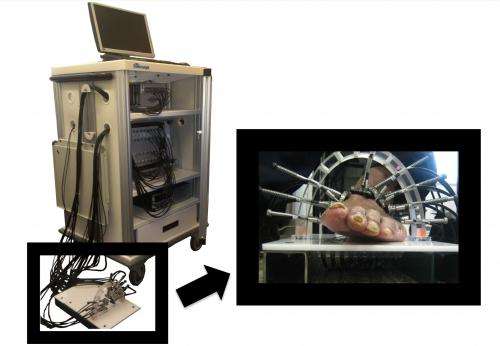Shedding new light on one of diabetes' most dangerous complications

For many diabetics, monitoring their condition involves much more than adhering to a routine of glucose sensing and insulin injections. It also entails carefully monitoring the ongoing toll this disease takes on their body.
An innovative new optical diagnostic tool created by Columbia University researchers and reported today in the Optical Society's (OSA) open-access journal Biomedical Optics Express may soon make it easier to diagnose and monitor one of the most serious complications of diabetes, peripheral arterial disease (PAD). PAD, which is marked by a narrowing of the arteries caused by plaque accumulation, frequently results in insufficient blood flow to the body's extremities and increases a person's risk for heart attack and stroke.
This new noninvasive imaging technique – known as dynamic diffuse optical tomography imaging (DDOT) – uses near-infrared light to map the concentration of hemoglobin in the body's tissue. This mapping can reveal how effectively blood is flowing to patients' hands and feet.
"Currently, there are no good methods to assess and monitor PAD in diabetic patients," explains Andreas Hielscher, Ph.D., professor of Biomedical and Electrical Engineering and Radiology, and director of the Biophotonics and Optical Radiology Laboratory at Columbia University.

"Patients with PAD experience foot pain, called 'claudication,' while walking," adds Gautam Shrikhande, M.D., assistant professor of surgery, and director of the Vascular Laboratory at Columbia's Medical Center. "This pain continues, even at rest, as the disease progresses. In more advanced stages, PAD patients develop sores or ulcers that won't heal. Then, cell death, a.k.a. 'gangrene,' occurs and amputation is often the only solution. It's extremely important to diagnose PAD early, because medication and lifestyle changes can alleviate the disease."
This is where DDOT can help. "We've successfully used DDOT to detect PAD in the lower extremities," says Michael Khalil, a Ph.D. candidate working with Hielscher at Columbia. "One key reason why DDOT shows so much promise as a diagnostic and monitoring tool is that, unlike other methods, it can provide maps of oxy, deoxy and total hemoglobin concentration throughout the foot and identify problematic regions that require intervention."
"Using instrumentation for fast image acquisition lets us observe blood volume over time in response to stimulus such as a pressure cuff occlusion or blockage," said Hielscher.
To map and monitor the presence of hemoglobin, the protein that carries oxygen in the blood, red and near-infrared light is shone at different angles around areas that are susceptible to arterial disease. These specific wavelengths of light are then absorbed or scattered, depending on the concentration of hemoglobin.
"In the case of tissue, light is absorbed by hemoglobin. Since hemoglobin is the main protein in blood, we can image blood concentrations within the foot without using a contrast agent," Hielscher points out. Contrast agents pose the risk of renal failure in some cases, so the ability to monitor PAD without using a contrast agent is a great advantage.
Since more than 25 million people—or 8 percent of the population—in the United States are diabetic, this diagnostic tool has the potential to make it significantly simpler to diagnose and monitor diabetics with PAD in the future.
Khalil, Hielscher, and colleagues hope to bring their diagnostic tool to market and into clinics within the next 3 years.
More information: "Dynamic diffuse optical tomography imaging of peripheral arterial disease," Biomedical Optics Express, Vol. 3, Issue 9, pp. 2288-2298 (2012). www.opticsinfobase.org/boe/abs … cfm?uri=boe-3-9-2288
Journal information: Biomedical Optics Express
Provided by Optical Society of America















